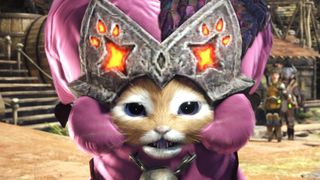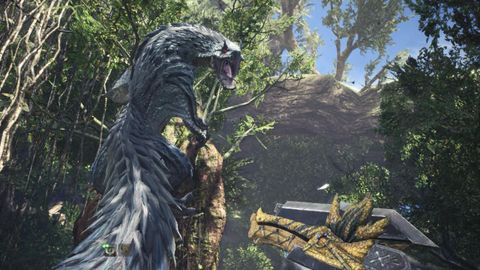Our Verdict
Monster Hunter: World’s thrilling fights with fantastic beasts never get old, even if they require tiresome item management during downtime.
PC Gamer's got your back
What is it? A dragon murder sim with excellent taste in clothes.
Expect to pay £50/$60
Developer Capcom
Publisher Capcom
Reviewed on GeForce GTX 1070, 16GB RAM, i7-7700HQ
Multiplayer 4-player co-op
Link Official site
"When in doubt, burn 'em out!" sounds like a line from Apocalypse Now, but in Monster Hunter: World your plucky sidekick shouts those words after steering a massive airship into a festering swamp of rotting carcasses. The biome is so large and regularly resupplied from the bountiful coral jungles above that it's developed a unique ecosystem supported by errant corpses fallen from the sky. It is disgusting and beautiful. You've come to make camp, kill the survivors, and make cool clothes from their skin.
Monster Hunter: World is a third-person action game about dominating the food chain and looking good doing it. It's renowned for its endgame grind, where you go on ever more complex and challenging hunts across diverse, tangled open worlds in search of rare items needed to craft an armor set that’ll no doubt crown you the min-max champion of the world. But Monster Hunter’s essence and greatest strength are its tense, desperate, and tragic fights with beautiful beasts that can go on for the better part of an hour.
It is also about the gleeful colonization 'new' lands and the slaughter of native species. Monster Hunter is a grotesque fantasy, but if you can stomach the merciless, repeated slaughter of god's beautiful dragon children, you'll find an excellent, endless action game that tests reflex and intellect in equal measure.
Creature feature
Unlike the story, murdering World's dozens of intricately designed monsters has a point. There’s no leveling up and skill point allocation in Monster Hunter, so crafting armor and weapons is the only way to permanently buff your stats. Gear crafted from monsters reflects their strengths and weaknesses, so if you’re having trouble with a thick-skinned fire type, you’d best go take down the thicker, hotter Ratholos for fire-resistant armor, and maybe seek out a poisonous monster for a weapon that does a bit more damage over time. Clear affinities between behavior, aesthetic, and the hard numbers that govern monster stats make deciding which monster to hunt next and which gear you’ll need to ruin them relatively easy to determine, though a few endgame fights might require some careful menu digging.

An anjanath 'drinks' a 'health potion'.
All 30-something monsters (with more on the way via free updates) have distinct personalities brought to life through realistic animation, observable behaviors, and detailed models. My favorite, the Paolumu, is a fuzzy pink and white bat creature that balloons like a blowfish when threatened. The Kulu-Ya-Ku is a big dodo bird that uses big rocks as its first line of defense. The Anjanath, a fire-breathing, chicken-winged T-Rex, would be the final boss in most games. Hitting one until it stops moving for the first time is an immense, sad accomplishment.
And then a Rathian plunges from the sky and captures an Anjanath in its claws, flailing your former final boss monster around like a ragged teddy bear. Somehow, they get bigger yet, with creatures that resemble fallen, very grumpy gods.
Gods or dodos, hunts work the same throughout the entire game. You ‘post’ a quest in Astera, the busy hub area, eat a quick meal to buff your stats, and if you’re playing with friends, you and up to three others embark to a particular biome. From there, you’ll wander an intricate environment in search of your monster. Scoutflies, sentient compass bugs, will point you to nearby crafting materials and monster tracks, always nudging you towards an inevitable fight.
Problem is, biomes are populated with monsters besides your target, and they’ll probably interrupt your fight. Letting them duke it out while you hide can work in your favor, sure, but staying out of the way isn’t easy. Environmental hazards complicate hunts further. Do you try to lure an Anjanath beneath a massive boulder strung up by vines above? Loosing it with your slingshot could flatten you too.
It's like ASMR, but with swords and dragons.
Monsters have no visible health bar, but they’ll appear tired and increasingly scarred the weaker they get. At certain intervals, they’ll make a break for it and try to find a place to sleep or prey of their own to eat in order to build HP and stamina, turning hunts into frenzied chases. Knowing your environment, where the monster might be headed, and the fastest way to get there only comes with experience.
When you can walk the line and land a rare, righteous combo directly on a Rathain's scaly dome, the feeling is euphoric.
That’s OK because World’s combat is strongest when it feels like a struggle. Swings with the greatsword take literal seconds of animation, the hammer requires getting too close for comfort, and even the mobile ranged weapons feel like unwieldy, clunky machines. I’m partial to the switch axe, a weapon that stores elemental damage in axe form and releases it in explosive bursts after transforming into a glowing sword the size of a teenager.
It still looks tiny to a burrowing sand wyvern or electric flying squirrel lizard. Big sword or not, you can and will get poisoned, paralyzed, burned, stunlocked, put to sleep and become subject to every attack your quarry can muster while you're helpless. Swings and shots from your friends can interrupt your own, and your every attempt to exhaust your movement abilities will also exhaust your character. For example, if you jump while sprinting to dodge an attack, your character will always leap forward and fall flat on their face. Remember: this is not your house, and you are very small.
Combat isn’t fun in the way it is in Dark Souls or Devil May Cry, which reward constant, fluid combos and perfect timing, but it is always tense, and often hilarious. And when you can walk the line and land a rare, righteous combo directly on a Rathain's scaly dome, the feeling is euphoric.
But so much gets in the way of that crunchy feedback loop. If the intent of crafting and gear management (the usual downtime activity between hunts) is to make you feel as if you've cultivated food, curated your looks, and performed the proper research required to take down whatever big boy is next on the list, then abstract menu interactions aren’t the most inventive or satisfying way to go about it.

Not quite a perfect port, World is a deceptive resource hog that likely won’t run at the high framerates you’d expect it to. You can read the full rundown in our performance analysis. But it is stable, and built with PC users in mind. Fully configurable keyboard and mouse controls are as cozy as any controller, and extensive graphics options will get it running just fine on older rigs with enough tweaking.
When the hunting portion of Monster Hunter is so vividly rendered by massive, believable creatures and lush environments, digging through menus to turn herbs into potions and potions into mega potions lacks the same ceremony. It's fine, in the end, because the menu interactions are streamlined enough that they're not impossible to parse and rarely tedious. Still, for as busy and complex as the crafting and item management appears, it’s painless in practice, simplifying the series’ formerly complex systems to such a degree that they don't even resemble the systems they're simplifying. Why not reinvent them at this point?
Monster Hunter: World also opens by bashing you over the head with text-heavy tutorials. You'll learn how to craft dozens of items immediately, most of which won't matter until a dozen hours in. Nearly every character in the Astora hub spews text about economies and changing item types, placing the fantasy of preparation on equal footing with filing taxes.
Vital tips are glossed over too, like how you can use piercing pods to prevent monsters from running away, or how to craft some of the most essential items. I appreciate withholding information from the perspective of a role-playing hunter, where only battle-hardened vets will have obtained the most arcane knowledge. But the bulk of World's inner workings are only accessible through wikis and hearsay, the assumption being that you'll figure some stuff out on your own, or collapse and turn to Google.
In the early hours, all you need to know is how to swing and dodge. It’s only when high rank missions are unlocked that you’ll need to do some research.
Killing time
It doesn't take long to kill most of the monsters and try a few weapons, so World complicates and extends itself by focusing on minutiae. It's why many will tell you that 'the real Monster Hunter' doesn't start until you finish the campaign. The first 20 hours of low rank play are fun and worth seeing, but to an extent it's true. World changes significantly in high rank play.
Hunts are remixed by adding layered objectives, like defeating multiple monsters in a shortened time frame or by juicing the elemental abilities of a previously weaker monster. New monsters continue to appear in the endgame, often requiring raid-like planning with a full team of four. As you progress further into high rank missions, small mistakes are met with massive punishments, and the study and preparation for a single hunt might require a whole new armor set and weapon.

Every weapon has a sprawling development tree.
It can be frustrating and slow, especially after the breezy hunts of the story campaign. And yet, every challenge is a natural extension of the combat system. Grinding out the best gear for a tough hunt is a smart, often necessary, idea, but if you know when to swing and when to run, you'll be alright.
High rank missions read like an artificial way to extend interest in Monster Hunter: World, but the series has always been preoccupied with grinding for obscure components to make a hat or sword with a difficult hunt in mind. It is Min-Maxing: The Game. Grindy, yes, but the grind is good. With so many modern games competing for time as much as money, Monster Hunter: World avoids feeling like an insatiable black hole by automating the usual busywork.
Bounties, small collection missions you can often complete during hunts, grant you items and upgrade materials. A greenhouse in the hub area allows you to cultivate herbs between missions, eliminating the need to collect them at all, eventually. The Tailrider Safari is a group of three adventurous palicos you send on missions to retrieve a random assortment of items from specific biomes, softening the need to grind out lower level hunts. And every armor set is unique, pulling in recognizable elements from the monsters they're made of, arranged in eccentric, stylish, extremely anime designs. They are worth the effort.
Like your character, Monster Hunter: World dresses its breathless combat in every assortment of the most arbitrarily complicated garb, all in the name of variety. It is an abyss of 'replayabilty’, an exercise in patience and observation for the ultimate payoff: an infinite black sea of invigorating dragon murder. And a new hat.
Monster Hunter: World’s thrilling fights with fantastic beasts never get old, even if they require tiresome item management during downtime.
James is stuck in an endless loop, playing the Dark Souls games on repeat until Elden Ring and Silksong set him free. He's a truffle pig for indie horror and weird FPS games too, seeking out games that actively hurt to play. Otherwise he's wandering Austin, identifying mushrooms and doodling grackles.

